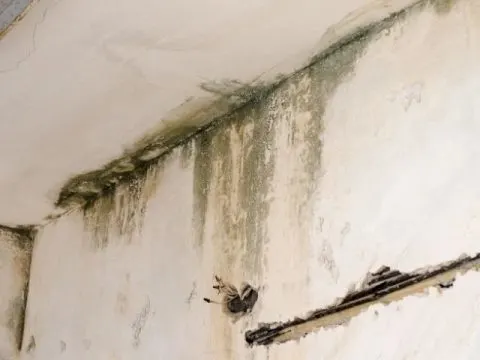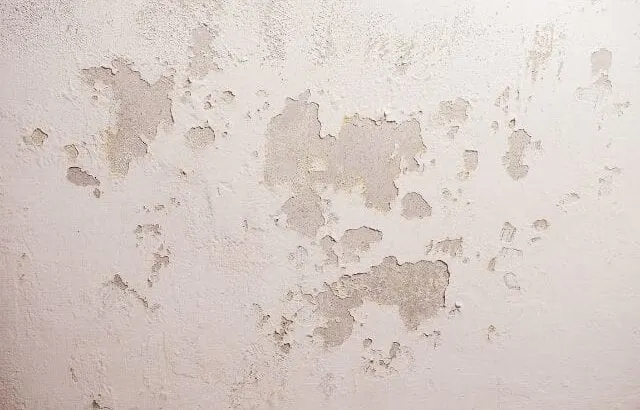Water makes up such a huge part of our planet that it is not surprising to find it in our homes. However, water damage is also a major problem in homes.
Often moisture shows up as condensation on the wall, or even moisture present inside the wall. Unless you can see a visible leak, humidity in the air is usually to blame.
You can check the moisture levels on and within walls using a pinless digital moisture meter (link to Amazon). They don’t require you to cut holes in the walls – they are completely non-destructive tools for measuring moisture.
I purchased one of these when I suspected moisture in the walls of my home. It made quick work of an otherwise stressful situation.
Excessive moisture leads to a host of health and construction problems. This article will detail how much moisture is too much, common problems associated with moisture and its main sources, and how to correct them.
How are Moisture Levels Determined?
All air holds a certain amount of moisture in the form of water vapor. We call this water vapor humidity. Humidity is determined by two factors: relative humidity and dew point.
Relative humidity (RH) measures how much moisture the air can hold based on the air temperature. Warmer air can hold much more moisture, hence the sticky feeling you get when in a hot, humid location.
This phenomenon matters in the home. If the air temperature inside is 70 degrees Fahrenheit with a relative humidity of 40 percent, you will be quite comfortable. In fact, the range of comfortable RH is between 30-50% (source).
But, If the temperature drops, so does the amount of water the air can hold, or its relative humidity. That same amount of moisture in the air at 44 degrees Fahrenheit will max out at 100% relative humidity.
The combination of temperature and relative humidity defines the dew point. Dew point is reached when condensation begins to occur, leaving water on cold surfaces in the home.
You may be thinking, “So what? I don’t allow my house to cool down to 44 degrees.” But condensation can occur on any surface that is cold enough to reach dew point—windows, uninsulated walls, and other cold locations.
Most often, if you are noticing moisture problems in your house, the relative humidity is well above the comfort level, which then requires less extreme temperatures to cause issues.
What’s the Big Deal with Humidity?
High moisture levels and relative humidity in the home can lead to a host of health problems and construction damage.
Moisture is even considered a pollutant by air quality experts. Why? Moisture causes mold and mildew growth, which can cause asthma and allergic reactions. More seriously, they have been linked to cancer, immune problems, birth defects, and tissue poisoning (source).
Moisture also contributes to the growth of dust mites, bacteria, and cockroaches.
And of course, moisture can cause damage to the building itself. Condensation can cause staining, deformed or decaying wood, paint damage, and powdery concrete.
And not all moisture sources are as conspicuous as a leaky roof or pipe. Read on to see the top sources of moisture that could be contributing to the moisture on and in your walls.

Common Indoor Sources of Moisture and How to Fix Them
Many sources inside the home increase the relative humidity of the home.
- People: The most surprising (and uncontrollable) sources of moisture in a home are the people and pets that live in it. A family of 4 can respirate over a gallon of water a day! (source)
- Domestic Activities: A broad range of actions we take every day add water vapor to the air. Cooking, bathing, laundry, and dishwashing are all large sources. You can lessen the humidity by:
- covering cooking pots
- Using exhaust fans
- Properly venting clothes dryers to outside
- Hanging clothes to dry outside
- Opening windows
- Combustion Appliances: Gas ranges and other gas appliances actually create water vapor, especially if not vented properly (which can also be dangerous). It is imperative to ensure that these appliances are vented well, and that the vents are not blocked for safety.
- Firewood storage: Firewood, even “dry” wood, holds a lot of water and shouldn’t be stored inside. Only keep a couple days’ worth inside.
- Attic chase leaks: Gaps around pipes, chimneys, and other air leaks can bring moisture into the attic. In fact, any air leak can bring moisture into the house. To correct, insulate any leaks you find with expanding foam.
- New construction materials: Interestingly, new construction takes a couple years to “dry out,” releasing moisture during the interim. Using a dehumidifier and/or running exhaust fans regularly during this time can help.
- Inadequate exhaust fan use: This is a common and easy mistake. Not using the exhaust fan during showers and cooking can lead to a surge in moisture levels. Consider an automatic switch to turn your exhaust fan on and off (link to Amazon).
- Houseplants: Houseplants can add a pint of water a day to the air. Although they also filter the air, they add to the relative humidity. Provide circulation and don’t overwater.
- Humidifiers: Using a humidifier in an already high relative humidity space is a no-brainer source. Humidifiers should be avoided at all costs.
- Plumbing leaks: This obvious source can add moisture to the home, besides damaging the space. Finding and repairing plumbing leaks will solve moisture problems, save building materials, and save money on the water bill.
Common Outdoor Sources of Moisture
Outdoor sources of moisture are often more obvious and visible. They include:
- Blocked downspouts
- Blocked foundation drains
- Concrete slabs with no moisture barrier
- Wicking water on below-grade walls
- Splash-back onto siding
- Damage to roofing or flashing
- Blocked exterior air circulation vents
To check for outdoor sources of moisture, conduct an exterior inspection. Look for blocked vents and downspouts, evidence of wicking or splash-back, and any damaged roofing or exterior building envelope materials.
By correcting these issues, you should solve the problems in your home that have caused moisture to condense on the wall. However, moisture can also penetrate inside the wall where you can’t see it, causing dry rot.
How to Protect Your Home From Dry Rot
Dry rot happens when water vapor penetrates into wood causing decay. It is a misnomer to call it dry rot, as it isn’t dry at all—just not visibly wet.
Most moisture enters wall cavities via air leakage. By properly sealing any chases that enter your home through the walls or basement, you can significantly reduce the risk of moisture.
Plumbing and wiring are the biggest culprits, as they run directly through wall spaces. Seal them with expandable foam, mildew-resistant caulk, or silicone.
Make sure moisture barriers are installed on the crawlspace floor. Vapor barriers such as Visqueen (link to Amazon) or vapor-retarder paint also can be applied to surfaces.
Finally, insulate walls and attics sufficiently, especially in older homes that tend to be less air tight. Insulation will reduce the temperature differentiations that cause moisture to condense on surfaces.
Special Case: The Modern Energy-Efficient Home
Strangely, modern homes are insulated and sealed so well that moisture problems can still be an issue, and in some ways even more so. Because moisture cannot except or flow through the space, it becomes trapped inside.
Especially in areas with cold climates, the difference between the outside temperature and the inside temperature in winter can cause condensation to occur, but because very little air flow naturally occurs, the areas stay wet longer.
A study by the U.S. Department of Energy found that increasing insulation on the exterior of the building envelope was the best way to reduce this problem.
Compared to insulation inside the wall cavity, which actually keeps the temperature lower, exterior insulation kept the sheathing at a higher temperature, thus raising the relative humidity (source).
What if adding exterior insulation just isn’t an option for your newer home? Then run exhaust fans frequently, while also opening a window at the opposite end of the house. By allowing air to flow through your home, the colder, drier air from outside will pick up moisture and help it flow out of the home.
Dehumidifiers are also very effective. I installed one in my garage to deal with moisture and condensation issues.
Conclusion
No matter what symptoms of moisture you are experiencing—musty smells, staining on the walls, mold growth, or condensation, to name a few—it is important to find the source and work to reduce or eliminate it.
If you have noticed moisture on your interior walls, then the level of moisture in your home has probably surpassed the recommended levels.
Water vapor affects the relative humidity of the home, and besides affecting your comfort level, it can affect your health and lead to serious problems with your building materials, such as dry rot.
Many sources of excessive moisture are found inside the home. These sources can often be mitigated by using exhaust fans that are vented to the outside.
Some sources of moisture originate outside and require regular maintenance and/or repairs to stop water from penetrating the building envelope.
In the end, correcting moisture problems in your house will protect your family and your home. Strive to maintain a comfortable level of relative humidity between 30-50%.
As a homeowner, I am constantly experimenting with making the structure of my house more energy-efficient, eliminating pests, and taking on DIY home improvement projects. Over the past two decades, my family has rehabbed houses and contracted new home builds and I’ve learned a lot along the way. I share my hard-learned lessons so that you can save time and money by not repeating my mistakes.


Leave a comment
You must be logged in to post a comment.